DRAFT – these instructions are not final, and are likely to change.
Hot end
You will need the following parts:
| # |
Component |
Qty |
Type |
| 1180 |
Brass nut |
1 |
Machined |
| 739 |
Heater block |
1 |
Machined |
| 1179 |
Threaded nozzle |
1 |
Machined |
| 1136 |
Heatsink |
1 |
Machined |
|
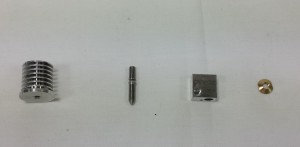 |
| Screw the nozzle into the base of the heatsink by hand. |
 |
| Screw the heater block onto the nozzle, again by hand. There is not need to use any tools at this stage. Take care to fit the heater block with the small hole nearest the nozzle tip. |
 |
| Fit the brass nut. Using an 8mm spanner, gently tighten the assembly until it is just over ‘finger tight’. The constriction in the nozzle has a very thin wall, so care should be taken not to over tighten the assembly as it may result in snapping the nozzle. |
 |
Bowden tube
You will need the following parts:
| # |
Component |
Qty |
Type |
|
Hot end |
1 |
Assembled |
| 1055 |
Bowden tube |
1 |
Hardware |
| 106 |
Bowden start |
1 |
Machined |
|
|
| Take the PTFE tube. Make sure the ends of the PTFE tube are cut square. (Filament has been inserted into tube just to show the tube against the background.) |
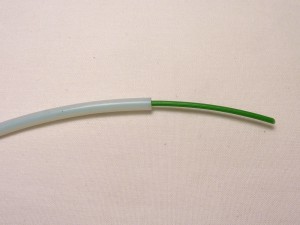 |
| You are going to screw the brass Bowden start and the heatsink onto each end of the tube. This will compress the PTFE tube’s inner hole. To allow the filament to run freely in the tube, you need to open out the ends of the PTFE tube first. Use a 2.5mm (2mm is too small, 3mm is too big) drill bit in a small hand chuck, or a slow electric drill. |
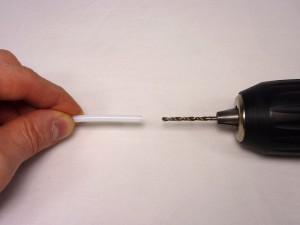 |
| Gently, and twisting clockwise all the time – never anti-clockwise, whether going in or coming out – use the drill bit to enlarge the inner hole in the PTFE, to a depth of around 10mm. Try to keep the drill as straight as possible into the tube. |
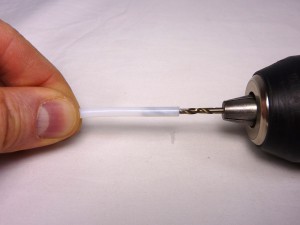 |
| Take several goes at it, going a couple of millimetres deeper each time and drawing the PTFE swarf out by keeping twisting clockwise and pulling. The drill should pull the PTFE swarf out with it. Repeat the process at the other end of the PTFE tube. |
 |
| IMPORTANT! The PTFE tube MUST BE CLEAR OF ALL PTFE SWARF before screwing the heatsink on! Push a piece of filament (use the 50cm piece you cut for the extruder testing) through the tube, which should push out any remaining PTFE swarf. Blow down the tube, from both ends, as well. It is very important to get any PTFE swarf out of the tube, otherwise this will end up in the nozzle the first time you print, blocking it! |
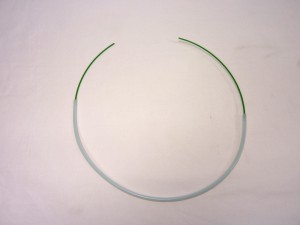 |
| Screw the tube into the heatsink as far as it will go, at which point the end of the tube will butt against the nozzle inside the heatsink. |
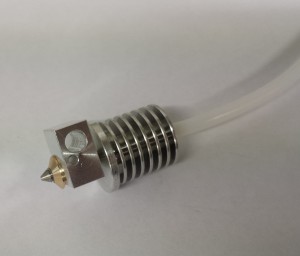 |
| Now you’re going to screw the brass Bowden end and the nozzle onto the PTFE tube. To help guide them onto the tube straight, put a piece of filament into the PTFE tube. This will keep the brass Bowden end (and nozzle) and PTFE tube axially in line; you don’t want them screwed on at an angle. Push the brass Bowden end up to the PTFE tube, and push while turning it clockwise. It will start to cut its own thread into the PTFE tube. |
 |
| If you have trouble getting the brass Bowden start started on tube, you can use a pencil sharpener to make a cone on the end of the tube. |
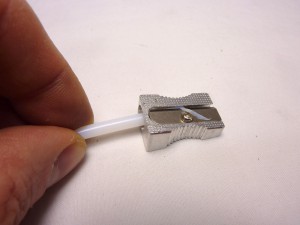 |
| Don’t cut too deeply with the pencil sharpener, which will make the cone too deep and long, or it will compress onto the filament when the brass Bowden start is screwed on. |
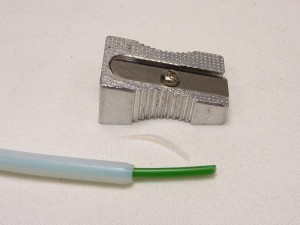 |
| Keep turning until the Bowden start will not screw on any further. If you then remove the brass union, you should see that the Bowden tube end has been threaded, to a depth of around 8mm. |
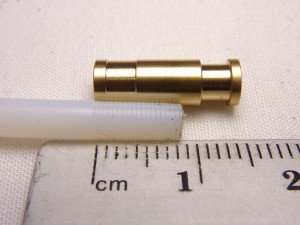 |
Head assembly
You will need the following parts:
| # |
Component |
Qty |
Type |
|
Hot end |
1 |
Assembled |
|
Effector |
1 |
Assembled |
| 212 |
M3 washer |
2 |
Fastener |
| 258 |
M3 nut |
2 |
Fastener |
|
 |
| Push the hot end assembly up through the effector assembly. Secure it in place using the M3 washers and nuts. Take care to orient the heater block as shown, without loosening the nozzle in the heatsink, before tightening the M3 nuts. |
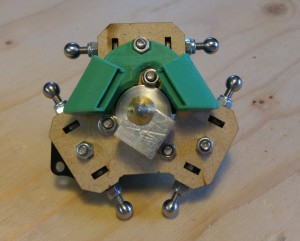 |
Thermistor wires
| # |
Component |
Qty |
Type |
| 433 |
Thermistor wiring – 160mm |
2 |
Hot end |
| 197 |
2.4mm Black heatshrink |
as needed |
Hot end |
|
New picture to come |
| If your thermistor wiring is supplied without heatshrink on both ends, and the female end looks like this, do the following. |
 |
| Fold in the two barbs that stick out the side, as shown in the first picture; a small screwdriver or tool with a point is easiest. They need to fold into the crimp, as they will hold the thermistor wire. |
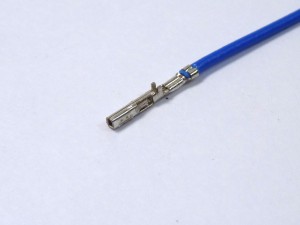 |
| Also flatten the top two tabs, so the crimp is smooth. If you put the heatshrink on with them sticking up, they can cut through the heatshrink, and cause a short circuit if they touch other metal. |
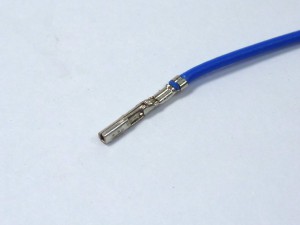 |
| Put the heatshrink on the end of the wire, covering the crimp but leaving the end open. |
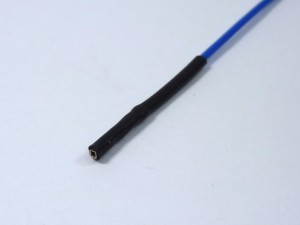 |
| Check that it holds the thermistor firmly. You will cover the thermistor with high temperature PTFE heatshrink in the next step; you want as little metal showing as possible between the PTFE heatshrink and the black heatshrink, to avoid short circuits to metal parts of the printer. |
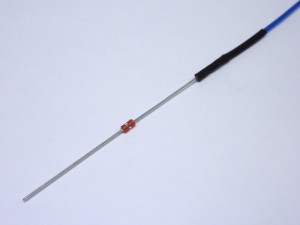 |
Thermistor and heater
You will need the following parts:
| # |
Component |
Qty |
Type |
|
Head |
1 |
Assembled |
| 430 |
Thermistor |
1 |
Electronics |
| 167 |
PTFE heatshrink |
1 |
Hardware |
| 197 |
Polyolefin heatshrink |
1 |
Hardware |
| 314 |
Cartridge heater |
1 |
Electronics |
| 133 |
Cable tie |
1 |
Hardware |
|
|
| Cut the transparent PTFE heatshrink about 8mm shorter than the thermistor with its axial connecting wires. Put the thermistor in it so that 4mm of wire protrudes from each end. |
 |
| Using a flame (a cigarette lighter, blowtorch, gas hob, or hot air gun work well; a hair dryer does not), shrink the heatshrink over the thermistor. Just waft the thermistor and heatshrink through the flame. You don’t want the heatshrink to overheat and to burn. |
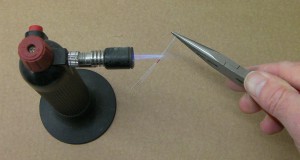 |
| If you’re doing this with a cigarette lighter, hold the thermistor at one end, and heat the heatshrink from the middle out to the other end. The heatshrink will be transparent when it has fully shrunk, and will then go back to opaque when the heat is removed. Keep it above, not in, the flame, so it doesn’t overheat and go black. |
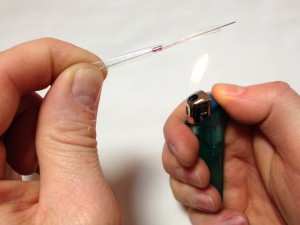 |
| Let it cool for a few moments, then turn it around and do the other side. Rolling the thermistor between your fingers while heating will improve the consistency of the heatshink. |
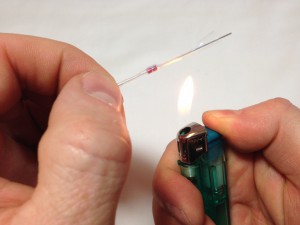 |
| Turn it around again and heat the first side, rolling it in your fingers, to get a really good, even heatshrink. Make sure it has shrunk properly around the central bulge, or it won’t fit easily into the heater block. |
 |
| This is how the thermistor should look with the PTFE shrunk onto it. |
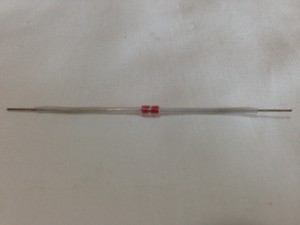 |
| Test the resistance of the thermistor with a multimeter. It should be around 100k ohms at an ambient temperature of 25C. Like the heated bed thermistor, the resistance will be greater if it is colder, and less if hotter. |
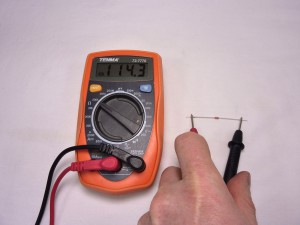 |
| Pull the thermistor through the heater block and route the legs as shown. Ensure the thermistor bead is seated inside the heater block. |
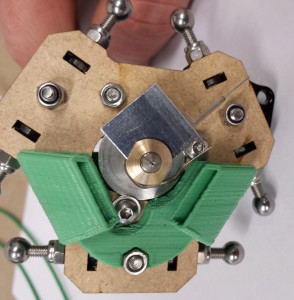 |
| Check the resistance of the heater cartridge. It should be around 7.0 ohms. |
 |
| Push the cartridge heater into the heater block. Insulate the thermistor wires’ female crimps with black heatshrink, then push onto the thermistor legs. Bundle the thermistor and cartridge heater wires and secure with the cable tie to the effector as shown. |
 |
Cooling fan
You will need the following parts:
| # |
Component |
Qty |
Type |
|
Head |
1 |
Assembled |
| 1194 |
50mm fan |
1 |
Electronics |
| 1264 |
P-clip |
1 |
Hardware |
| 112 |
M3x25mm cap head screw |
1 |
Fastener |
| 212 |
M3 washer |
1 |
Fastener |
| 204 |
M3 Nyloc nut |
1 |
Fastener |
|
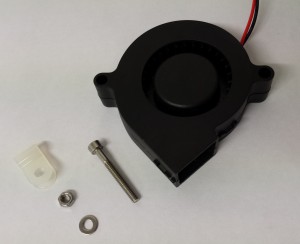 |
| Trim the fan as shown. |
 |
| Push the cap head screw through the top hole in the fan spacer. Slide the fan onto the screw, then rotate it until it rests in the pocket of the printed part. Secure the fan and hot end wires with the P-clip and M3 washer and Nyloc nut. Take care to route the wires as shown. |
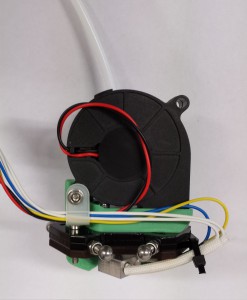 |
Hot end connector
CAUTION! The next step describes wiring up the hot end connector. GREAT CARE should be taken doing this. The heater cartridge and the fan wires have 19V running through them ALL THE TIME. The thermistor wires are 3.3V, and connect directly to the Arduino chip on the Duet. If you incorrectly wire the plug, a short circuit between the thermistor wires and any of the other wires MAY DESTROY YOUR DUET!
Wiring diagram
NOTE: The wiring diagram below, and pictures, show RED heater cartridge wires. Yours will be white.
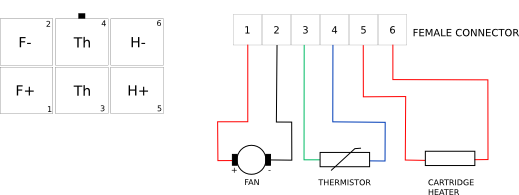
| Put the pins on the ends of the wires into the six-way female socket. The wiring diagram, above, is looking into the back of the socket, where you insert the crimps. The little black rectangle is the locking tab, and the housing has small embossed ‘1’ and ‘6’ numbers on it, so you can orientate it as the diagram. The pins are crimped on one side, and smooth on the other. The smooth sides go downwards in the diagram. |
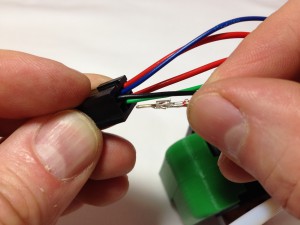 |
| Neither the thermistor nor the heater cartridge have a polarity so it doesn’t matter which way round their wires go. (Though the H+ and H- are the way that the machine will apply power – hence the labels.) Make sure to get the polarity of the fan right. This picture shows one of the fan wires being put into the housing, but it is not fully in yet; you can’t see the crimp easily when it is. |
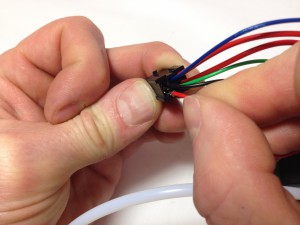 |
| Check that the pins are all the same depth into the housing. The pins are very difficult to remove without damaging them, so check twice, plug in once! They should click into place, and then shouldn’t easily push further through, or pull back out. |
 |
Wire colours, related to hot end wiring loom
| Wiring loom |
Hot end wires |
| 1 Yellow |
Red FAN wire (+19V) |
| 2 White |
Black FAN wire (ground) |
| 3 Green |
Thermistor wire (green/blue/yellow, 3.3V) |
| 4 Blue |
Thermistor wire (green/blue/yellow, 3.3V) |
| 5 Purple |
Thick WHITE heater wire (+19V) |
| 5 Black |
| 6 Red |
Thick WHITE heater wire (ground) |
| 6 Brown |
| You can check the wire order by comparing it to the end of the hot end loom, which the hot end plugs into. NOTE: in this picture, the two RED wires, top right, are the heater wires. Yours will be white, not red. |
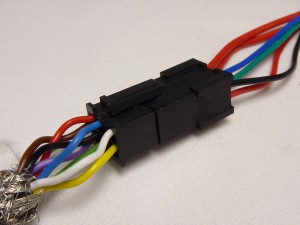 |
| The completed assembly. |
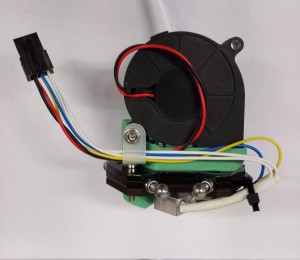 |








































